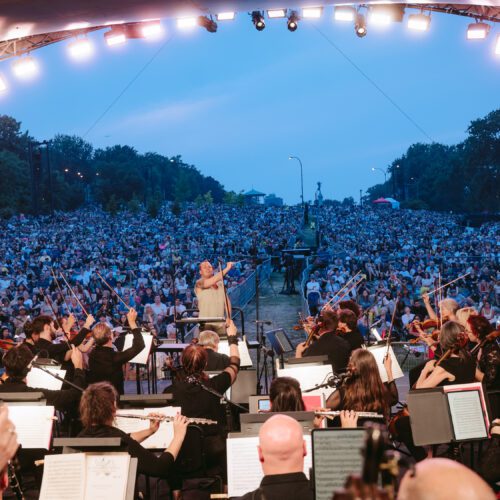The PAN M 360 team is very present at the Virée classique, presented by the MSO. Our contributors report daily on what they have seen and heard at the concerts presented in Montreal until August 20.
Payare Conducts Carmina Burana: A Powerful Evening
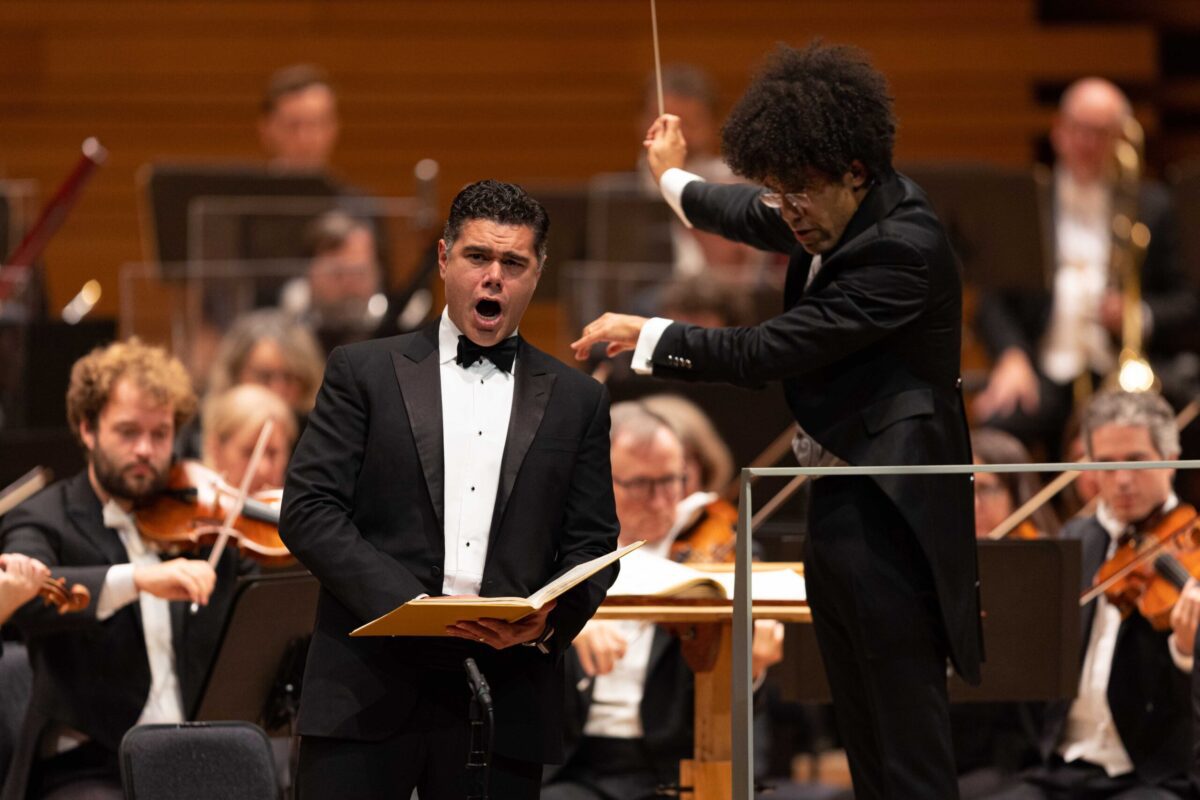
Photo credit: Antoine Saito
The Maison symphonique was packed to the rafters last night to hear the OSM and its choir perform Carl Orff’s celebrated Carmina Burana. The Petits chanteurs du Mont-Royal and three soloists, soprano Sarah Dufresne, baritone Elliot Madore and countertenor Nicholas Burns, also joined the orchestra to perform the work. The octobasse was also used in the first and last movements.
When the Wheel of Fortune begins to turn, it doesn’t stop. The same can be said of the OSM’s interpretation: once the famous “O Fortuna” has been intoned (at a tempo that’s almost too fast), the following movements follow one another with no time for breath. The orchestra, especially Payare, has energy to spare. The conductor literally danced on the podium. The percussion and brass are powerful, and the rest of the orchestra is solid. The chorus, for its part, enunciates the texts with remarkable clarity. The singers are precise, delivering a performance of exceptional quality. The soloists shone on stage not only with their great vocal qualities, but also with their stage presence and acting. Indeed, the soloists acted out the poems they were singing, sometimes giving rise to quite comical moments (think of the swan’s lament, performed by the countertenor).
The evening unfolds under the sign of power, strength and emotion. Listening to this Carmina Burana is like discovering it for the first time, so bold and solid is the interpretation. Time seemed to stand still for the duration of the concert, and we witnessed a great moment of music. The audience, who reserved their applause for the very end of the concert, cheered the orchestra at the end of the evening for several minutes. This afternoon’s performance is already sold out, which just goes to show how popular this concert is!
Elena Mandolini
Wynton Marsalis’ Trumpet Concerto

Photo credit: Antoine Saito
Although recognized as a pillar of co-contemporary jazz for almost half a century, Wynton Marsalis has always been associated with the classical world. The supravirtuoso has mastered the repertoire and codes since childhood, and his post-graduate studies at Juilliard propelled him into the ranks of the great classical interpreters, before he became an uncontested leader of acoustic jazz in the early ’80s. At the time, many disparaged his desire to link jazz with the world of “great music”, attributing to him instead a conservative approach. Four decades later, time has proven the director of the famous Jazz At Lincoln Center program, of which he is still artistic director, right: Wynton Marsalis has done far more than simply resurrect the hardbop and modal jazz of the 50s and 60s, and his career has involved a clear appropriation of modern and contemporary forms of Western classical music. This is what we were able to appreciate on Saturday in the Canadian premiere of his Trumpet Concerto, played by OSM principal trumpeter Paul Merkelo.
Divided into 6 movements, the work begins with a march built on modern harmonic frameworks and involving advanced techniques for the solo instrument, all based on a groove uncommon to symphony orchestras, interspersed with non-binary rhythmic sequences. It is clear that Maestro Rafael Payare and his musicians have perfectly grasped the orchestral challenges of exploring these intersecting universes and adopting greater flexibility in their execution. Ballad, the work’s second movement, is a rich evocation of the great jazz orchestras at the heart of the previous century, from George Gershwin and Duke Ellington to the great Broadway musicals. Dedicated to the legacy of the Latin trumpet, the 3rd movement is the most demanding of the Concerto, both in terms of instructions for the soloist and the orchestra. We continue with Blues, a slow movement that explores African-American sensibility in a symphonic context, followed by French pastoral with its impressionist allegiances, and concluding with Harlequin, which integrates all the colors put forward in the five preceding movements.
Paul Merkelo acquits himself extremely well, the advanced techniques provided for the soloist are equal to the composer’s demands, and the OSM’s support proves to be perfectly balanced, except for a few insignificant details in the interpretation. In short, a successful Canadian premiere! Now let’s hope that time will do its work and that the classical public will appropriate this new facet of serious music, as did this thousand or so music lovers, including jazzophiles obviously unfamiliar with classical forms. This Canadian premiere was preceded by a magnificent work by the late Montreal composer José Evangelista, inspired by the 50th anniversary of our metro in 2016.
Alain Brunet
Fiddler’s Tale: Wynton Marsalis, Take 2
A little later, on the reconfigured Salle Wilfrid-Pelletier stage, a second work by Wynton Marsalis was presented on Saturday. Fiddler’s Tale is an African-American adaptation of Stravinsky’s L’Histoire du soldat (The Soldier’s Tale), whose narrative is an encounter between a violinist and the devil. Set in modern America, Wynton Marsalis’s adaptation is entirely written out, but plunges its performers into a contemporary sound universe even closer to jazz than the composer intended in his Trumpet Concerto. Elements of primitive, swing, modern and contemporary jazz are interwoven with orchestral devices typical of contemporary chamber music. For this Stravinskian evocation, Marsalis used the same instrumentation as for L’Histoire du soldat: violin (Marianne Dugal), double bass (Eric Chappell), clarinet (Alain Desgagnés), bassoon (Mathieu Harel), trumpet (Stéphane Beaulac), trombone (James Box), percussion (Joshn Wink). Conducted by conductor Dina Gilbert, this work is accompanied by a real-time narration between the 9 tableaux, provided beautifully in English by Nantali Indongo. Interesting, but sometimes a little long-winded. Classical musicians are now better suited to jazz, but such a work requires a better mastery of its expressive codes, which was not always the case. Or one could question the integration of jazz and blues in this score. But all in all, Dina Gilbert’s direction gave this performance the unity and cohesion necessary for successful concerts, despite our reservations.
Alain Brunet
Soothing Follies

There was a special calm and serenity in the Piano Nobile to hear the performance of Sylvain Bergeron on archlute and Margaret Little on viola da gamba. The underlying theme was madness, and more specifically folia, the famous musical theme of the eponymous dance that first appeared in 15th-century Europe. Like the Dies Irae, folia has been reclaimed and used by composers of every era, from Antonio Vivaldi to Sergei Rachmaninov. The two comparses have thus put together a program in which each piece highlights the joint interaction of their instruments, as well as its individual value. Of particular interest was the solo viol piece A Soldiers Resolution by the English composer Tobias Hume (1569-1645), himself a soldier in the service of the King of Sweden, where each movement idiomatically translates an element of soldierly life (march, battle drum, retreat), or the multi-character Faronells divisions upon a ground by Michel Farinel (1649-1726). The folies d’Espagne by Marin Marais (1656-1728) concluded this musical journey, so typical of Renaissance music, which makes time stand still, transporting us to another era and another almost mystical experience.
Pedagogical, the two instrumentalists took the time on several occasions to explain a few facts about their respective instruments, such as how they work and how they differ from modern instruments, even inviting the audience to come and see them once the performance was over, bringing this crazy morning to a close in the most convivial of ways.
Alexandre Villemaire
Schubert and Brahms: Shadows and Light

Photo credit: Antoine Saito
The premise of the short chamber music concert presented on the Salle Wilfrid-Pelletier stage was very sombre. Indeed, the program spoke of resignation in the face of death, a resignation sometimes tinged with anxiety. However, the musical selections were full of light and moments of hope. No tears of sadness on this Saturday morning (but tears of emotion, perhaps…).
The concert opened with Jeremy Denk at the piano, playing Franz Schubert’s peaceful Impromptu no. 3 in G flat major. The introspective, meditative and melancholy character of this piece lent itself perfectly to the intimate ambience of the concert. Through light, calm arpeggios, a deep, tormented melody emerges. The pianist portrayed all these emotions brilliantly and clearly.
Johannes Brahms’ Piano Quartet No. 3 in C minor, Op. 60 then completely changed the tone of the concert. The atmosphere of contemplation was quickly transformed into a moment of musical frenzy. The energy and precision of the performers (Jeremy Denk on piano, Alexander Read on violin, Victor Fournelle-Blain on viola and Nicolas Alstaedt on cello) are to be commended. This quartet offers many technical challenges, with instruments exchanging melodies, great contrasts in nuance and rhythmic passages. Their performance is breathtaking. We hear all the drama, all the power and all the ardor of Brahms’ compositions.
The audience is clearly captivated by the music: the quality of listening is exceptional, and long moments of contemplative silence separate the end of the works from the beginning of the applause.
Elena Mandolini
Dutilleux, Bach and Kodály by Nicolas Altstaedt
Unquestionably a master of his instrument, not only for its exceptional technical level but also for its expressiveness, German cellist Nicolas Altstaedt invited music lovers to the Piano Nobile for a performance of three works requiring the re-tuning of his instrument in order to extend its timbral and harmonic spectra. Like many of today’s classical artists, he bridged the gap between the Baroque period and contemporary music, wrapping an almost rigorist version of JS Bach’s Cello Suite no. 5 in C minor BWV 1011 in a work by Henri Dutilleux commissioned in 1976 by Rostropovich, Trois strophes sur le nom de Sacher (a great Swiss conductor dedicated to contemporary music) and the superb Sonata for solo cello, Op. 8 by Hungarian composer Zoltán Kodály.
The advanced techniques required for this immense sonata, now considered one of the great masterpieces for solo cello, are brought to the fore here by the soloist, whose playing is outstanding. A captivating concert from start to finish, with a few birds chirping – given the imperfect soundproofing of the PdA’s bay window. Totally tolerable under the circumstances!
Alain Brunet
La Virée Makes a Stop in Bali!
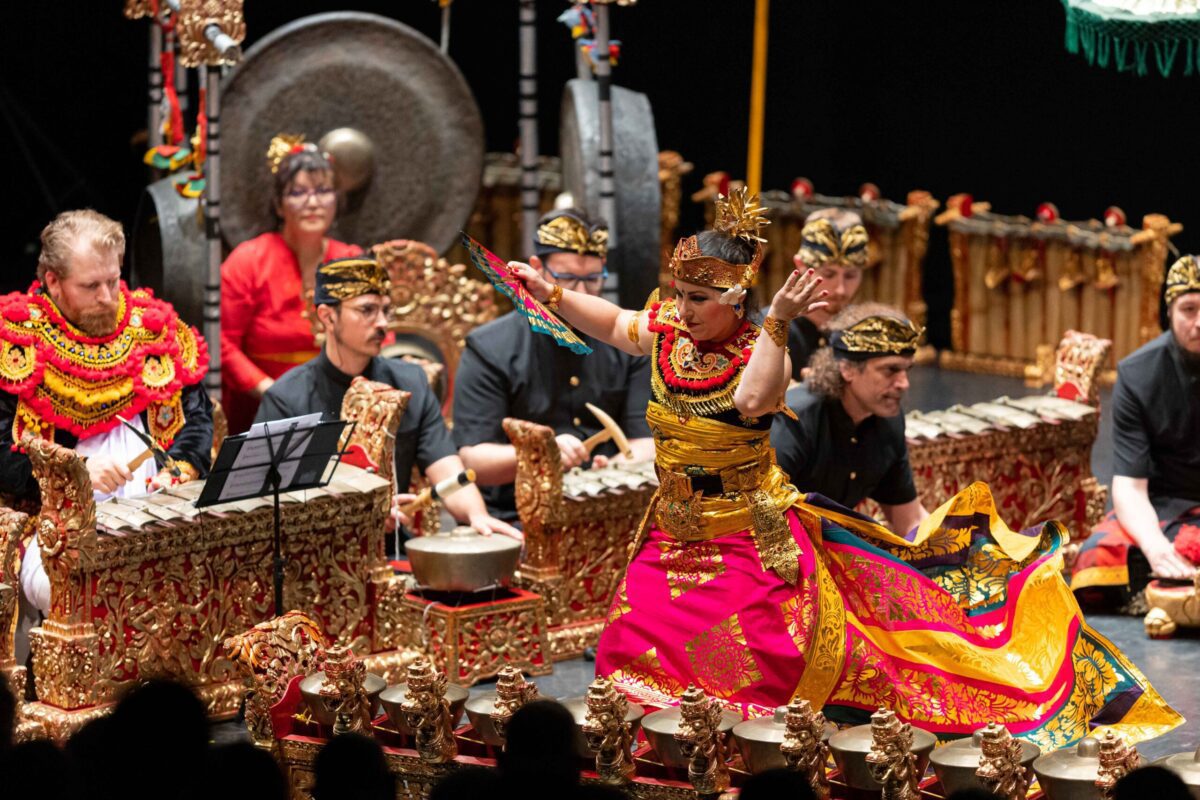
Photo credit: Antoine Saito
La Virée classique was enlivened on Saturday by the intriguing and harmonically rich sounds of the Indonesian gamelan. The Giri Kedaton ensemble offered a fascinating concert on the stage of Salle Wilfrid-Pelletier, but there was also a series of activities throughout the day that allowed the public to learn more about this lesser-known musical art form.
Firstly, Virée visitors had the chance to become part of the gamelan at an outdoor workshop. Participants of all ages were invited to try out the richly decorated percussion instruments, a gift from the Indonesian government in 1986, and create basic arrangements under the guidance of ensemble members. This was followed by a talk on the origins of gamelan and the different styles that exist, providing a clearer picture of what this music represents. Although of noble origin, it is nevertheless designed to be easily accessible, while allowing for virtuosity through different instrumentation and instrumentation.
This virtuosity was evident throughout the concert. The research behind Giri Kedaton is colossal, and the result of decades of experience with Balinese masters. You can feel how at ease the musicians are in front of their respective instruments. And not just one! Between each piece, the musicians reorganized themselves, settling behind new instruments or simply in a different section. Although the orchestra is organized in much the same way as the classical tradition, with a conductor, soloist and sections, there is no real hierarchy of roles. The musicians form a single whole, offering the audience a true spectacle.
The ensemble’s showmanship was on full display. The musicians, dressed in traditional garb, were having fun and it showed. Dancing also had its place during the concert, with two traditional performances by members of the ensemble. The female dancer simply stole the show, with a mystifying choreography based on intense yet elegant poses and expressions. The mask dance was equally intriguing, with its wordless story, but we regret that the stage layout was not adapted to the needs of the staging. A large part of the audience on the sides were unable to observe the entire choreography. But this did not detract from the quality of the music. Alternating between more traditional music and more contemporary works, the entire concert is marbled with rhythms that are both complex and accessible. Of particular note is O Bali by José Evangelista, founder of the gamelan workshop at the Université de Montréal and a leading figure in Balinese music in Montreal, who passed away earlier this year. A beautiful tribute.
Alexis Ruel
George Sand and Frédéric Chopin’s Epistolary Relationship Accompanied by His Music

Under the title Un hiver à Majorque : correspondances entre George Sand et Frédéric Chopin, BAnQ librarian Esther Laforce and pianist Jean-Christophe Melançon, winner of the Étoiles Stingray – Choix du public and Prix du jeune public at the OSM 2022 Competition, offered a reading, both textual and musical, with the question: “What did an author and a composer write about each other? Although this question was answered, the musical content was well constructed, but left us a little disappointed.
Opening the session, Esther Laforce reminded us that the epistolary exchanges presented were not the intimate correspondence between the two lovers, which had been destroyed, but rather letters sent to their friends in which they talked about each other. The relationship between George Sand – Aurore Dupin, Baroness Dudevant by her real name – and Chopin takes shape in letters addressed to Eugène Delacroix and Polish politician Albert Grzymala, among others. The pieces chosen serve as musical illustrations to the text of the letters read out by the speaker. But which pieces? We had no idea. No program, no visual aids to help us find our way around. Connoisseurs will no doubt have recognized the Prelude no. 15 in D flat major, known as “Raindrop”, but the other excerpts, performed with great accuracy by Melançon, are not. One would have expected to know the names of the pieces performed by the pianist.
We can certainly applaud Esther Laforce’s research, excellent contextualization and narrative, but we’d have liked to have more to sink our teeth into. In the end, we’ve learned about both, but we’d have liked to hear more about the famous stay in Mallorca and the move to the Carthusian monastery in Valldemossa, which comes at the end of the activity and is so intrinsically linked to the development and writing of the preludes. The vein is good, but would benefit from being widened.
Alexandre Villemaire
A UFO at Virée classique: humor and energy at Complexe Desjardins
The Complexe Desjardins stage is a fantastic idea. What could be better than listening to a concert while dining or shopping? The installation during the Virée classique was a great opportunity to hear talented orchestras in the background. But it was impossible to ignore the energy of Saturday’s lunchtime concert.
L’OVNI (Orchestre à vent non identifié) filled the Complexe space with their expansive sounds and eclectic repertoire. The musical setting of tales and stories that make no secret of their absurd humor was a success, thanks in particular to the variety of styles chosen and a solid brass section that gave the orchestra power. Full of contrasts, the works were delightfully frivolous at times, then imposing and weighty at others. It was hard not to notice the famous Dies Irae in the score.
Alexis Ruel
Journey Through Europe and Styles on the Harp
Matt Dupont introduced the audience to the fascinating and varied repertoire for harp. The Espace culturel Georges-Émile-Lapalme was perhaps not the best place to present a recital for solo harp, even if amplified. Indeed, the Espace culturel happens to be a very busy and noisy crossroads, so that the softer, lower passages were almost inaudible. Despite this, Matt Dupont’s presence on stage drew the listener in: after just a few notes, an attentive silence settled over the audience.
The program featured works from the 19th and 20th centuries, combining grand cascades of notes, virtuoso passages and humorous melodies. Dupont’s interpretation is fluid, graceful, assured and powerful. We are captivated and even hypnotized by the beauty of the music. Between each piece, the musician briefly introduced the work and its composer, a welcome addition to this short performance. Despite the inconveniences of the concert venue, the works and their interpretations were nonetheless appreciated.
Elena Mandolini
The “Little” Great Music of Obiora and Payare
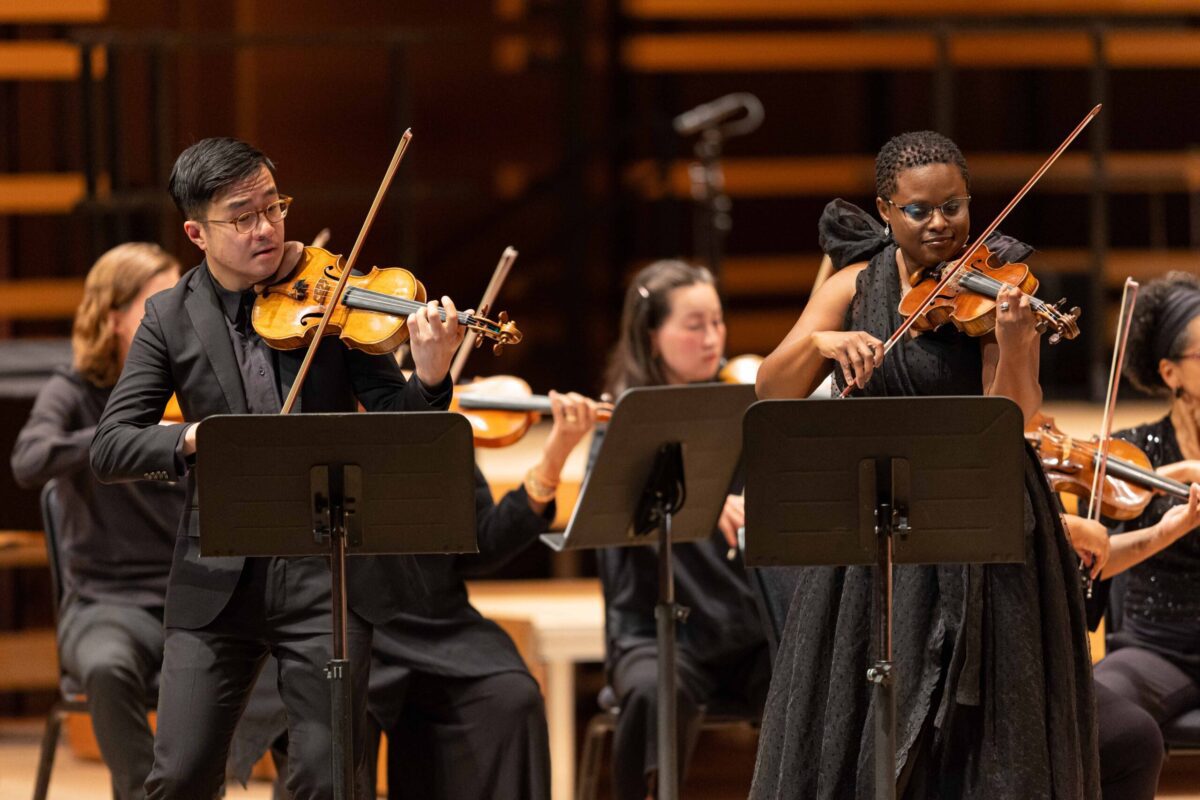
Photo credit: Antoine Saito
The Ensemble Obiora, founded in 2021 by Allison Migeon, is Canada’s first music ensemble made up largely of professional musicians from diverse backgrounds, and took to the Maison symphonique stage to conclude its second year of participation in Virée classique. There has undoubtedly been a shift in the vision and scope of Virée classique over the past year. The fact that a young ensemble like Obiora is part of the programming, and that the conductor of the Orchestre symphonique de Montréal comes to conduct them to help them grow, testifies to Payare’s interest in giving visibility to other ensembles.
For the occasion, the conductor had chosen short pieces, but no less devoid of effects. It could be easy to fall into the easy way out with a universally recognizable piece like Mozart’s Little Night Music. Not so with Rafael Payare. Like a master goldsmith, he searches for precise nuances and dynamics, inviting the musicians to go right to the end of the musical lines to give complexity to this most famous work. The concert’s highlight, the Symphonie concertante pour deux violons no. 2 in G major by composer Joseph Boulogne, chevalier de Saint-Georges, born the son of a slave in 1745, saw OSM concertmaster Andrew Wan join Obiora concertmaster Tanya Charles Iveniuk in a most dynamic and electrifying performance. In a form inspired by the concerto grosso of the Baroque era, the two soloists engaged in a vibrant instrumental dialogue supported by the members of the orchestra, particularly in the cadenza of the second movement, in which all the freshness and vitality of the Chevalier’s music is expressed. The concert concluded with the romantic musical language of the Holberg Suite in classical style. In fact, after at least half an hour of bouncy, joyous music, we were treated to the most introspective moment of the concert in this suite, with a maudlin, pious Air. The evening ended on a festive note, to rapturous applause and a sense of pride both in the audience and on stage.
Alexandre Villemaire
Lightning Talk with Nantali Indongo

Nantali Indongo is the host of CBC Radio’s The Bridge. She is also known on the Montreal music scene for her 17 years with the hip-hop group Nomadic Massive. But for Virée classique, it’s her talents as a storyteller that will be put to good use. She will be narrating Wynton Marsalis’s Fiddler’s Tale, a tale of a talented violinist’s pact with the devil.
Nantali Indongo was short of time, having only twenty minutes to devote to the interviewer before having to go to the sound check in preparation for the Marsalis piece. A short, but nonetheless highly enriching interview on the blending of musical genres was held at the Espace culturel Georges-Émile-Lapalme. Wynton Marsalis is best known for his jazz work, but he also composes for more classical contexts. In Fiddler’s Tale, the jazz idiom is subtly integrated into the traditional classical score in a manner so fine as to be self-evident. The conversation quickly moves away from jazz and classical to hip-hop and rap. It was in fact a very brief and condensed history of these styles that was presented, proving that the Virée classique is the stage for musical encounters of all kinds.
Elena Mandolini
Movie Classics by the FILMharmonique Orchestra

The FILMharmonic Orchestra, directed by Francis Choinière, is a Montreal-based string orchestra specializing in the performance of film music. We know them for their ciné-concerts at the Maison symphonique or Salle Wilfrid-Pelletier, where the music is performed during the screening of a film.
As part of Virée classique, the FILMharmonique orchestra presented its favorite soundtracks. The pieces on the program are fairly expected: The Pink Panther, Cinema Paradiso, Schindler’s List and Lord of the Rings follow one another. But the orchestra also had a few surprises in store for the audience, including a medley of themes from the film Ratatouille, and La passion d’Augustine (the soundtrack for which was composed by François Dompierre).
The orchestra’s musicians put on a fine show. Their energy, and that of the conductor, is contagious. Many works end with a forest of bows suspended in the air. The evening’s soloists (an oboist, a flutist and a violinist) are excellent, interpreting the works with great sensitivity. It’s a pleasure to rediscover well-known pieces from the film music repertoire, in good spirits and good fun.
Elena Mandolini
Godwin Friesen in Recital: Delicacy, Suavity and Precision
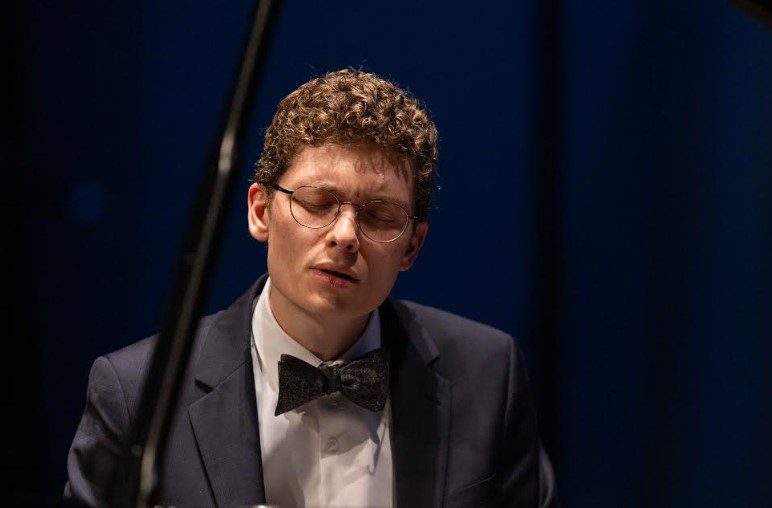
Photo credit: Antoine Saito
For most of those present at this recital, it was the discovery of Godwin Friesen, winner of the OSM Competition 2022. What immediately strikes one about this young man is the combination of delicacy and firmness in his piano playing. This is first apparent in Joseph Haydn’s Piano Sonata in A flat major, Hob. XVI:46, velvety smooth and impeccably precise. From the classical composer, we move on to a Bach-inspired Prelude and Fugue in A major composed by the performer. This reveals the musician’s great intelligence, capable of updating the aesthetics of the German genius of the Baroque period, before serving up the main course, a very modern Sonata by Canadian composer Jean Coulthard (1908-2000). The young virtuoso concludes with Franz Liszt’s demanding Hungarian Rhapsody No. 6, a must in piano music for any performer with high aspirations. Here again, Godwin Friesen’s suavity rests on both the sobriety of his playing and his precision and brilliance at opportune moments.
Alain Brunet




